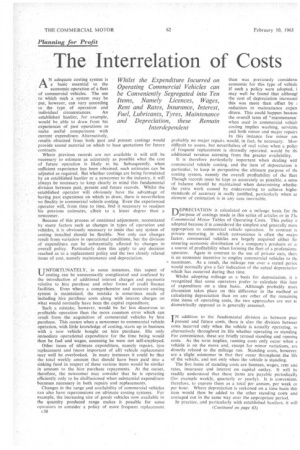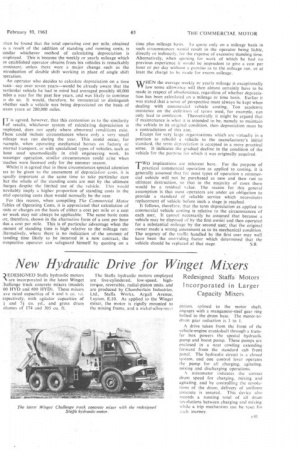Planning for Profit
Page 76

Page 79

If you've noticed an error in this article please click here to report it so we can fix it.
The Interrelation of Costs
AN adequate costing system is a basic essential to the economic operation of a fleet of commercial vehicles. The use to which such a system may be put, however, can vary according to the type of operation and individual circumstances. An established haulier, for example, would be able to draw from his experiences of past operations to make useful comparisons with current expenditure. Alternatively, results obtained from both past and present costings would provide sound material on which to base quotations for future contracts.
Where previous records are not available it will still be necessary to estimate as accurately as possible what the cost of future operation is likely to be. Subsequently, when sufficient experience has been obtained, such estimates can be adjusted as required. But whether costings are being formulated by an established haulier or a newcomer to the industry, it will always be necessary to keep clearly in mind this fundamental division between past, present and future records. Whilst the established operator will obviously have the advantage of having past experience on which to draw, there is nevertheless no finality in commercial vehicle costing. Even the experienced operator will, from time. to time, find it necessary to readjust his previous estimates, albeit to a lesser degree than a newcomer.
• Because of this process of continual adjustment, necessitated by many factors such as changes in types of operation and vehicles, it is obviously necessary to insist that any system of costing installed should be flexible. Not only can changes result from variation in operational conditions, but the division of expenditure can be substantially affected by changes in overall policy. Particularly does this apply to any decision reached as to a replacement policy and the two closely related items of cost, namely maintenance and depreciation.
UNFORTUNATELY, in some instances, this aspect of ‘--) costing can be unnecessarily complicated and confused by the introduction of additional interest charges and payments relative to hire purchase and other forms of credit finance facilities. Even where a comprehensive and accurate costing system is maintained, the mistake is sometimes made of including hire purchase costs along with interest charges on what would normally have been the capital expenditure.
Such a mistake, however, would be far less disastrous to profitable operation than the more common error which can result from the acquisition of commercial vehicles by hire purchase. This occurs when a newcomer to commercial vehicle operation, with little knowledge of costing, starts up in business with a new vehicle bought on hire purchase. His only immediate operational expenditure for the time being would then be fuel and wages, assuming he were not self-employed.
Other items of ultimate expenditure, namely repairs, tyre replacement and (most important of all) vehicle replacement may well be overlooked. In many instances it could be that the total weekly amount that should have been paid into a sinking fund in respect of these various items would be similar in amount to the hire purchase repayments. At the outset, therefore, the newcomer may consider that he is operating efficiently only to be disillusioned when substantial expenditure becomes necessary in both repairs and replacements.
Changes in the range and availability of commercial vehicles can also have repercussions on ultimate costing systems. For example, the increasing size of goods vehicles now available in the quantity produced range makes it possible for some operators to consider a policy of more frequent replacement c38
than was previously considere( economic for this type of vehicle If such a policy were adopted, i may well be found that althougl the cost of depreciation increased this was more than offset by reduction in maintenance expen diture. This could happen becausi the overall term of "maintenance. when used in commercial vehicli costing implies washing, servicirn and both minor and major repairs In this instance few minor am probably no major repairs would, in fact, be necessary. Mon difficult to assess, but nevertheless of real value when a polic of frequent replacement is shrewdly operated, would be th! additional revenue accruing from the greater availability.
It is therefore particularly important when dealing witt commercial vehicle costing, and the item of depreciation it particular, to keep in perspective the ultimate purpose of tIn costing system, namely the overall profitability of the fleet Though records must be kept as accurately as possible, a sensi of balance should be maintained when determining whethel the extra work caused by endeavouring to achieve highei standards of accuracy is really justified, particularly when at element of estimation is in any case inevitable.
L./ EPRECIATION is calculated on a mileage basis. for tin purpose of costings made in this series of articles or in Th4 Commercial Motor Tables of Operating Costs. This policy i! adopted because it is considered the simplest and generally more appropriate to commercial vehicle operation. In contrast te private motoring, in which convenience is often the majoi factor, commercial vehicles are largely acquired either fo ensuring economic distribution of a company's products or a! a source of profitability when forming the fleet of a professiona operator. Again in contrast to the use of private cars, ther■ is an economic incentive to employ commercial vehicles to flu maximum. As a result, the mileage run over a stated perioc would normally give a fair indication of the actual depreciatior which has occurred during that time.
Whilst adopting mileage as a basis for depreciation, it recognized that some operators prefer to calculate this hen
of expenditure on a time basis. Although probably more discussion takes place on this difference in the method 01 calculating depreciation than on any other of the remainins nine items of operating costs, the two approaches are not Sc diametrically opposed as is generally assumed.
IN addition to the fundamental division as between past present and future costs, there is also the division betweer costs incurred only when the vehicle is actually operating, oi alternatively throughout its life whether operating or standing For convenience, these are briefly termed standing and runnii4 costs. As the term implies, running costs only occur when LI vehicle is on the move and, except for minor variations, arc directly related to the mileage run. Standing costs, however, are a slight misnomer in that they occur throughout .the life of the vehicle, and not only when the vehicle is standing.
The five items of standing costs are licences, wages, rent and rates, insurance and interest on capital outlay. It will bc readily understood that these items are payable periodically (for example weekly, quarterly or yearly). It is convenient, therefore, to express them as a total per annum, per week or per hour. Where depreciation is reckoned on a time basis this item would then be added to the• other standing costs and averaged out in the same way over the appropriate period.
In practice. and particularly with established hauliers. it will (Continued an page 63)
iften be found that the total operating cost per mile, obtained is a result of the addition of standing and running costs, is iimilar whichever method of calculating depreciation is :mployed. This is because the weekly or yearly mileage which in established operator obtains from his vehicles is remarkably :onsistent. unless there were a major change such as the ntroduction of double shift working in place of single shift tperation.
An operator who decides to calculate depreCiation on a time msis--say over seven years—would be already aware that the aarticular vehicle he had in mind had averaged possibly 40,000 stiles a year for the past few years, and was likely to continue .13 do so. It would, therefore, be immaterial to distinguish /whether such a vehicle was being depreciated on the basis of ;even years or 280,000 miles.
IT is agreed, however, that this contention as to the similarity of results, whichever system of calculating depreciation is :mployed, does not apply where abnormal conditions exist. Fhese could include circumstances where only a very small nileage was run during the year. This could occur, for :xample, when operating mechanical horses on factory or nternal transport. or with specialized types of vehicles, such as hose used spasmodically in civil engineering work. in )assenger operation, similar circumstances could arise when roaches were licensed only for the summer season.
Whilst it is agreed that in these circumstances special attention las to be given to the assessment of depreciation costs, it is iqualty important at the same time to take particular care hat the whole of the standing costs arc met by the ultimate :harges despite the limited use of the vehicle. This would nevitably imply a higher proportion of standing costs in the otal operating costs than would normally be the case.
For this reason, when compiling The Commercial Motor Fables of Operating Costs, it is appreciated that calculation of :oats or charges on the basis of either a.cost per mile or a cost mr week may not always be applicable. The same basic costs ire, therefore, shown in the alternative form of a cost per hour 'Ins a cost per mile. This is of particular advantage when the :mount of standing time is high relative to the mileage run: ilternatively, where there is no indication of the amount of landing time likely. to he incurred in a new contract, the wospective operator can safeguard himself by quoting on a
time plus mileage basis. To quote only on a mileage basis in such circumstances would result in the operator being liable. directly or indirectly, for the expense of excessive standing time. Alternatively, when quoting for work of which he had no previous experience it would be imprudent to give a cost per hour or per day without a proviso as to the mileage run, or at least the charge to he made for excess mileage.
WHEN the average weekly or yearly mileage is exceptionally low some allowance will then almost certainly have to be made in respect of obsolescence, regardless of whether depreciation has been calculated on a mileage or time basis. Earlier it was stated, that a sense of perspective must always be kept when dealing with commercial vehicle costing. Too academic insistence on the definition of terms used, for example, can only lead to confusion. Theoretically it might be argued that if maintenance is what it is intended to be, namely to maintain the vehicle in its original condition, then depreciation must be a contradiction of this aim.
Except for very large organizations which are virtually in a position to .rebuild a vehicle to the manufacturer's initial standard, the term depreciation is accepted in a more practical sense. It indicates the gradual decline in the condition of the vehicle for the purpose for which it was originally acquired.
TWO implications are inherent here. For the purpose of .. practical corrunercial operation as applied to costing, it is generally assumed that for most types of operation a' commercial vehicle will not be purchased as new and then run to ultimate .destruction, so that in the majority of cases there would be a' residual value. The reason for •this general assumption is that most operators are under an obligation to provide 'a 'standard of reliable service which necessitates replacement of vehicle before such a stage. is reached.
It follows, therefore. that the term depreciation as applied to commercial vehicle costing is relative to the circumstances 'of each user, It cannot necessarily be assumed that because a vehicle may he disposed of by the first owner and then Operated Icir a substantial mileage by the second. user, that the original owner Made .a wicing assessment as to its Mechanical condition. The urgency of the traffic handled by the first user May well have been the overriding factor which determined that the
vehicle shotild be replaced at that stage. S.13,




























































































































